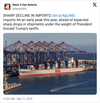How Rapido’s People-First Nearshoring Model Reduces Turnover and Boosts Long-Term ROI
Nearshoring works when teams stay. Explore how Rapido’s training-driven, people-first model creates long-term value for logistics operations.
Peak season imports into the U.S. slowed sharply in 2025, with Chinese exports plunging 27% year-over-year and carriers cutting sailings as tariffs and inventory frontloading reshape trade flows.

The annual surge in freight shipments bound for the United States has failed to materialize this year, as tariffs and early inventory frontloading have left little cargo moving ahead of the holidays. Data shows that while peak season typically runs through October, this year containerized imports from China peaked in July.
According to Vizion, Chinese exports to the U.S. have posted three consecutive weeks of 27% year-over-year declines, with little sign of recovery ahead of China’s Golden Week holiday. Catherine Chien, chairwoman of Dimerco Express Group, said: “Normally, we would expect a peak starting from the last week of September ahead of Golden Week. So far, there are no clear signs or major orders in the market indicating this trend.”
The top product categories driving the decline include:
“Toys and sporting equipment are on trend with 2024, but in the most recent 10 weeks after the peak, it has trended flat at an average of 20% less volume compared to last year’s peak season,” said Kyle Henderson, CEO of Vizion.
Industry analysts point to the frontloading of inventory earlier this year as a key factor. President Donald Trump’s short-term extensions on tariff implementation triggered a record surge of imports in May and June, followed by a rapid drop-off.
Honour Lane Shipping described the effect as “a very short lived, but strong spike in late May and early June,” followed by “a swift decline and slow recovery.” Many U.S. retailers, having built up inventory, have since paused shipments.
The Port of Los Angeles reported record container volumes in July, but those gains have not carried into fall. Carriers have announced at least 35 blank sailings for October, and the ONE Alliance has suspended a key Asia–U.S. route between Chinese ports and California.
Reduced container availability has pushed up prices. Carriers are implementing a $1,000 general rate increase per forty-foot container starting September 15.
Sea-Intelligence reported that North America is the only global region experiencing negative container volume growth during the trade war period, underscoring the broader impact of tariffs.
“Typically, ocean peak season, when the bulk of holiday goods are shipped, starts in July and continues through October,” said Noah Hoffman of C.H. Robinson. “This year, it peaked in July.”
The National Retail Federation’s Global Port Tracker shows import cargo volumes are expected to steadily decline for the remainder of the year. NRF’s Jonathan Gold noted: “The uncertainty of U.S. trade policy is making it impossible to make the long-term plans that are critical to future business success.”
Hackett Associates founder Ben Hackett added, “The trade outlook for the final months of the year is not optimistic.”
According to the Logistics Managers’ Index, the slowdown is already affecting transport and storage providers. “The fact that we saw freight capacity go up in August of all months suggests that there isn’t much freight left to move,” said Zachary Rogers of Colorado State University.
Source: CNBC
Join over 14K+ subscribers to get the latest freight news and entertainment directly in your inbox for free. Subscribe & be sure to check your inbox to confirm (and your spam folder just in case).